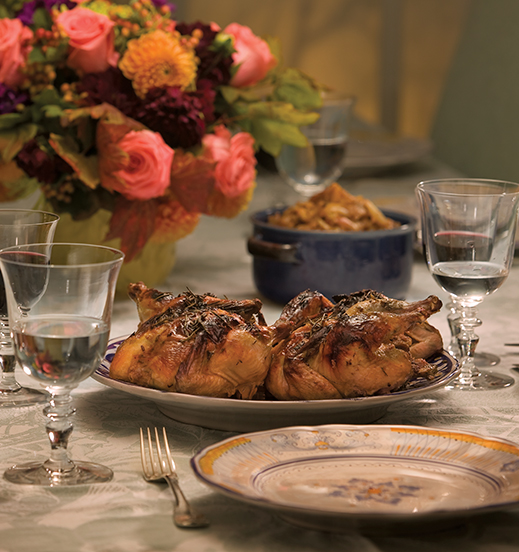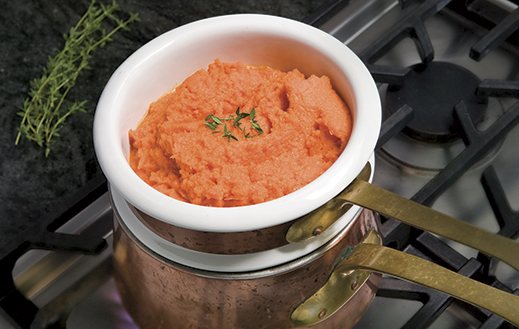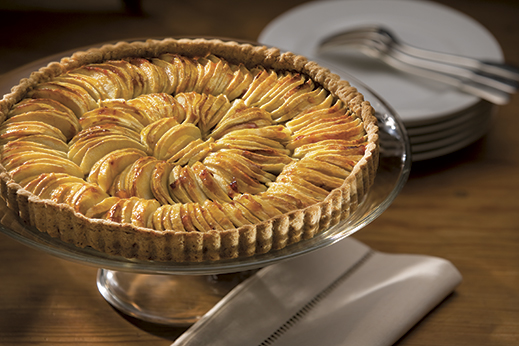
I like to think of the food that comes from this season as a reflection of the following simple philosophy. Nature has in its annual harvest, offered up some of its most delicious elements; a luscious fig, an ornamental pomegranate, a perfectly ripe delicate pear, a rotund pumpkin and an avalanche of exquisite tubers. Rushing their preparation and the subsequent eating of such splendors seems to be contrary to the season itself.
History it seems agrees. From the time of the ancient Greeks, Romans and Egyptians, annual festivals have occurred to celebrate the harvest. For thousands of years the human race has, in all parts of the world, taken the time to give thanks for the abundance that surrounds them.
The Jewish harvest festival, Succoth, is held in either September or October. It stems from the time of their exodus from Egypt, during which Hebrews traveled in the wilderness on route to Canaan. During their pilgrimage, they lived in makeshift shelters called a succah. They also gathered in sukkot (the plural of succah) to pray and eat together. As a result, Succoth is also known as the Feast of Tabernacle. During harvest time, farmers also lived in sukkot in their open fields. During this festival, farmers pray and thank God for the crops. It is a tradition that continues to this day, with festivities taking place outdoors.
Every year on October 4th, the Ancient Romans celebrated the Cerelia Harvest, an event that honored Ceres, the goddess of corn, (the origin of our word cereal), with festivities that included parades, games, sports and feasts. Modern day ‘Thanksgiving’ is an extension of just that.
Since 1621 Americans have annually given thanks for the abundance that befalls them. When Governor William Bradford proclaimed this day, they celebrated with their neighbors, their fellow pilgrims and with Chief Massasoit and the Wampanoag Tribe. The Native Americans brought many of the dishes served that day. They feasted upon oysters and eel, ate goose, venison and corn bread with leeks and watercress and had berries and plums, washed down with sweet wine. A menu that would be fitting today.
It is a holiday which I have entirely embraced since I came to California. A holiday where families come together and eat together. There are no other constraints, no pressure for gifts and it is universally enjoyed by all in America, irrespective of ethnicity or religious preference. What better way to honor a season.
Thanksgiving Day is a perfect allegory for a delicious autumnal day, just not as elaborate. Growing up in London our Sundays were often like this. We would take huge long walks across the heath on blustery days with billowing white clouds scooting low across the London skyline. We would fly kites and run pell-mell down the hills, play hide and seek and climb trees. Then home to a languorous lunch that often shuffled into dinner. Hearty soups such as the Celeriac Soup played a prominent part in those meals, followed by roast chicken or pork tenderloin with apples and prunes. As more friends dropped by, another plate would be added to the dinner table and conversations were lively and animated. It is a tradition which I enjoy to this day.
Autumnal meals bring warmth and nourishment and ideally create a culinary landscape in which we are all active participants, whether picking fruit from an apple tree, laying the table or chopping vegetables together in the kitchen. Edwin Way Teale, one of America’s great naturalists, once wrote ‘For man, autumn is a time of gathering together. For nature, it is a time of sewing, of scattering abroad’. So as nature sheds her splendid crimson coat and edges towards hibernation, I like to imagine all of us pulling up a chair at our dinning tables and sharing a meal, such as this one, with our friends.
CELERIAC SOUP WITH PANCETTA AND CRÈME FRAICHE
I spent my first Thanksgiving in Newport Rhode Island in freezing weather. My lovely friend Brooke cooked a feast fit for kings. We began with an aromatic soup and we ate for hours as the winds howled outside. Over the past two decades I have cooked Thanksgiving each year with great pleasure. We - as all families do I am sure – now have our own traditions. One of ours is to begin the meal with a soup, but each year it is a new soup, one usually created for that day. This is one of our favorites and I now make it many times during the autumn and winter months. It is warming and fragrant and perfect when the wind is howling or in our case, a chilled day by the California Coast.
Serves 12 people
4 medium sized celeriac – peeled and coarsely chopped
3 medium sized potatoes – peeled and chopped
2 large onions, finely chopped
10 cups vegetable stock
4 or sprigs fresh thyme
1 bay leaf
2/3 cup cream
Salt and pepper
4-5 slices pancetta – diced
2/3 cup crème fraiche – placed in a small bowl
Small bunch chives – finely chopped
I have over the years roasted many stuffed turkeys, as tradition warrants. Recently I have tried some new dishes and found that Cornish hens – stuffed or otherwise – are a great substitute for a huge turkey, particularly if you can find organically raised hens. We are fortunate to have at our local farmers market a lady who has just that. They are succulent and moist. Filled with the Grand Marnier stuffing and basted with the juices of luscious oranges it is a fitting dish for the occasion.
Serves 12 people
6 Cornish game hens
For the stuffing:
3 sausages (choose either spicy Italian, pork, turkey or chicken of your choice) taken out of its sausage casing and cut into small pieces.
1/3 cup olive oil
2/3 cup Grand Marnier
1 cup orange juice
2 large yellow onions – finely diced
1 lb. small Crimini mushrooms – cut into quarters
1 lb. assorted dried fruit – apricots, prunes, dates etc of your choice – cut into small pieces
4 garlic cloves – crushed
1 oz Herbes de Provence
salt and pepper
2 large oranges – cut in half
olive oil
6 sprigs fresh rosemary

Serves 8 – 12 people as an accompaniment
2 lbs. carrots – peeled and cut into ¼ rounds
2 oz butter
2 tablespoons chives – finely chopped
2 sprigs fresh thyme – leaves removed from the stems
salt and pepper
TURNIP PUREE
Serves 8 – 12 people as an accompaniment
2 Lbs. turnips – peeled and cut into 1 inch chunks
½ cup crème fraiche
2 tablespoons freshly chopped parsley
salt and pepper

TARTE FINE AUX POMMES
Whereas I make a new soup and have tinkered with the main course for Thanksgiving annually, there is one dish I make without fail at the request of my godson Charlie and his brother William with whom we have shared this holiday since the year he was born. It is a dessert I learnt to make with my mother when I was little and I have loved it ever since. It is filled to the brim with apples and is to me the epitome of an autumnal dessert.
Serves 8
For the pastry:
5 oz unbleached all purpose flour – sifted
5 oz almond meal or almond flour
6 oz slightly softened butter – cut up into small pieces.
1 large egg
Pinch of salt
For the apples:
2 tablespoons sugar
2 tablespoons Calvados
1/ 3 cup apricot jam
8 large apples (Granny Smiths, Golden Delicious, Gala’s – a mixture is also fine) peeled, quartered and cut into thin even slices.
Origins: Apples are the most widely cultivated fruit in the world. They originated in Asia Minor and grew wild in Europe in pre-historic times. From Greek mythology - Zeus and his bride Hera are said to have received a tree with golden apples on their wedding day – to great classic poets such as Homer who wrote of apples in The Odyssey in 800BC, the fruit has been part of the world’s cultural and gastronomical heritage. The Greeks, Romans and Ancient Persians all cultivated, grafted and wrote about apples. Shakespeare spoke of them in his plays and Sir Isaac Newton, inspired by watching falling apples discovered the laws of gravity. Certain cultivars are closely associated with their countries of origin, Cox’s Orange Pippins and Russets in the UK for example and Golden Delicious in the US. Granny Smith’s originated in Australia, McIntosh in Canada and Reinettes are a French specialty. One of the most scented apples known as Calville Blanche d’Hivers, a rare variety form Normandy, that dates back to the 1500’s, is said to be the most delectable of all.